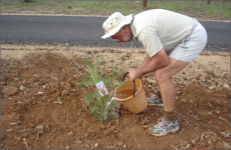Local North Queensland information for Local North Queenslanders.
Every gardener these days knows the importance of being water-wise in the garden.
Here’s the drum from the experts…
 Before You Plant:
Before You Plant:
If you are not planting your plants straight away, your plants will need to be watered daily while they are still in the pots. So it is better to get your garden beds ready for planting before you buy the plants, rather than be holding plants for several days.- Planting:
Water your plants before you plant them. If the mix is too dry it may fall away and damage the roots. Root damage at the time of planting is a very common cause of plant death. For this reason, you should NOT tease out the roots when you are planting, since this is a sure way to kill plants, especially grevilleas. - Watering-in:
 What you MUST do when you plant is water-in each plant with about a bucket full of water, as soon as possible after planting. You should plant a few plants, then water them in. DON’T plant the lot, have cup of tea, and then water them in. Even if it’s raining you must still do this. The reason for this watering-in is to settle the soil around the root-ball of the plant. If there is complete contact with the potting mix, moisture from the soil will easily transfer to the roots of the plant.
What you MUST do when you plant is water-in each plant with about a bucket full of water, as soon as possible after planting. You should plant a few plants, then water them in. DON’T plant the lot, have cup of tea, and then water them in. Even if it’s raining you must still do this. The reason for this watering-in is to settle the soil around the root-ball of the plant. If there is complete contact with the potting mix, moisture from the soil will easily transfer to the roots of the plant. - Immediate After-care:
For the first few weeks after planting, your plants will need special attention. The soil must be kept very moist for this period. How often you water them will depend on your soil type, the time of the year and prevailing weather conditions.As a rule of thumb, water your plants every day for the first couple of days, then twice a week for few weeks, then once a week etc. until they are established. Light sandy soils near the beach or basalt soils (covering most of the Atherton Tableland) will require more water than clay-based soils such as near Kuranda.
It takes about three months to establish a plant, and for this time you will need to monitor them carefully. Most species will give you some warning when they need water – the leaves will wilt.
- Long Term Maintenance:
If, once your plants are established, you continue to water them every few days or even every week, the roots will remain on the surface. This will mean that your plants will blow over easily during a storm or cyclone, and you will not be able to leave them for a couple of weeks without watering.If you want to be able to go away on holidays for a few weeks, and not have to worry about your garden, you must adopt the correct watering regime.
The principle is simple:

- prepare your garden beds correctly before planting
- water very well when you do water, but don’t water too often.
The idea is to thoroughly soak the ground, equivalent to about 50 mm of rain, and then delay the next watering for as long as possible. If you have well drained soil you can leave the sprinklers in the same place for two or three days. In clay soils you will have to shift them as soon as water starts to run, but you must keep shifting them back till the ground is completely soaked.
A good time to start this program is during the wet season. You should stop watering when the wet season starts and not start again till the plants really need it. This could be as long as September or October. The heavy rain during the wet will thoroughly soak the ground, which will then dry out very slowly. See how long you can leave your plants without watering them. With native plants it is quite feasible to establish the plants, then never have to water them again. You can do this if you have the correct plants for your area. By watering only two or three times during the dry season you can greatly increase the number of species that will survive in your area.
Water-wise gardening …
Every gardener these days knows the importance of being water-wise in the garden. You may have seen the strong advertising and education campaigns being run in the media.
There’s plenty of people out there giving advice, but much of it misses the mark, since it fails to mention the importance of good strong root growth, which is THE KEY!
So, here’s the real drum on minimising your use of water in the garden.
The secret is simple—encourage deep root growth so that when the ground dries out the plants can seek out water deep beneath the surface.
- Soil preparation
Thorough soil preparation is THE KEY. Make sure that the roots of your plants can penetrate deep into the soil. Plants with large healthy root systems are the survivors when the going gets tough. Large healthy root systems can only develop in well-prepared, thoroughly loosened soil. - Watering
Develop a watering regime in which you thoroughly soak your garden every few weeks without any watering in between. This means that the water will penetrate deep into the soil. The roots will follow the water down, and your plants will then have the ability to survive dry periods without stress. - Mulch
A thick layer of organic mulch is essential. This not only reduces evaporation and minimises water use, but it also keeps the soil cool, and conditions the soil as it breaks down. - Plant natives
Provided you plant natives suitable to your area, natives in general require far less water than exotic plants. And you can still choose lush tropical-looking plants if you follow points 1-3 above. ‘Native’ does not have to mean dull and boring!
Water-in each plant with about a bucket full of water, as soon as possible after planting.
Tips:
Do:
- Prepare your garden beds correctly before planting.
- Water your plants before planting.
- Water-in each plant with a bucket full of water as soon as possible after planting.
- Use plenty of mulch.
- Water very well when you do water, but don’t water too often.
Drippers or Sprinklers?
Drippers apply water directly to a limited area immediately around the roots of the plant. The surrounding soil remains dry, and so there is no encouragement for the roots to grow out beyond the dripper zone. In fact, the dry surrounding soil may even suck water away from the plant.
On the other hand, sprinklers water the entire garden bed and thus encourage good strong root growth out into the surrounding soil. Providing your watering regime is thorough but infrequent (as explained elsewhere in this Info Sheet), sprinklers are a better way of watering your plants than drippers.

